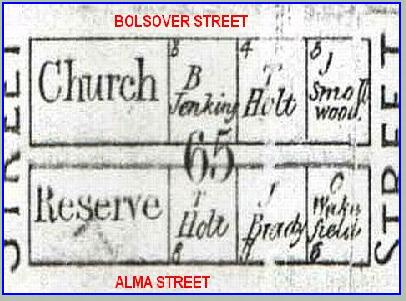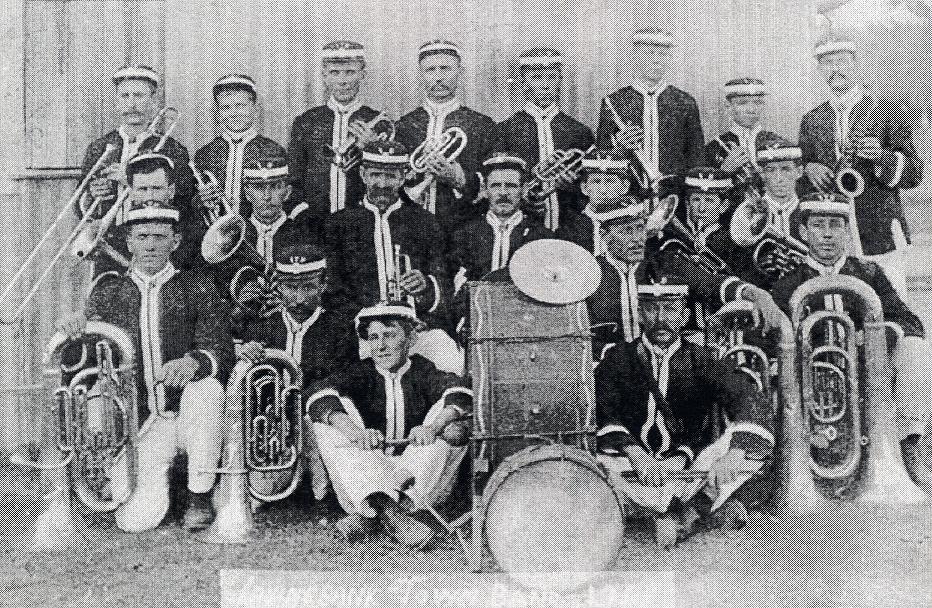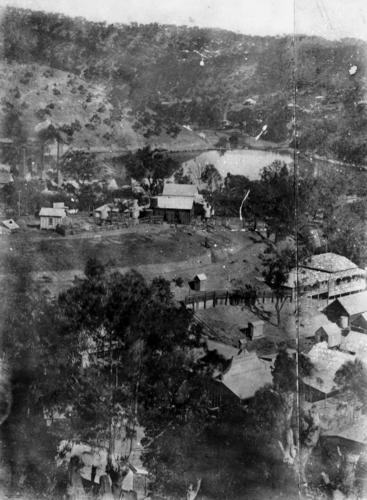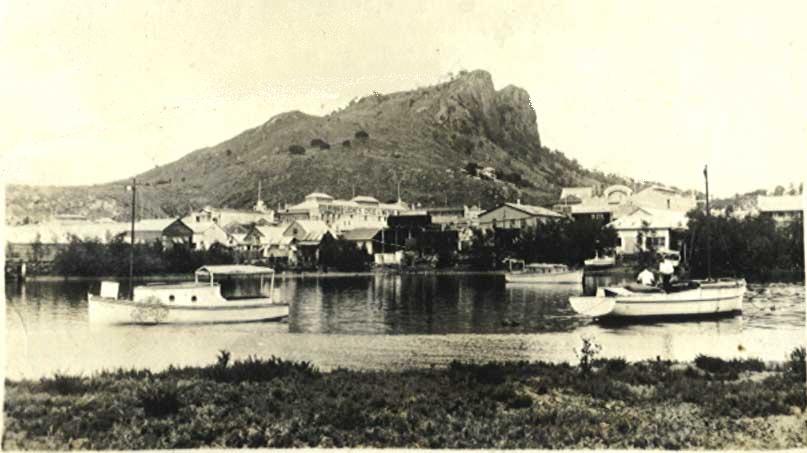Arthur Stanley SMALLWOOD 5
- Born: 16 Jul 1877, Rockhampton, Queensland 142,143
- Marriage: Mary Ellen PARSLOW on 26 Nov 1901 in Townsville, Queensland 23,141
- Died: 5 Apr 1939, Townsville, Queensland at age 61

 Events Events

• This was possibly the house that Arthur grew up in, as it was one of the houses that John, his father, built.

• A map showing the location of the Smallwood residence indicates exactly where Arthur lived in Bolsover Street - corner of Stanley Street. We can see the name "J. Smallwood" on the top right of this map - his father, John. This information is from 1878, when young Arthur was just one year old.
Although this map is recorded as being issued in 1863, we believe the same block of land was in the Smallwood family for many years.

• Arthur was enrolled at the Rockhampton Primary School at the age of 7 years, in 1884. He also enrolled in 1885, at the age of 8 years and two months.
The history of young Arthur's school - the Rockhampton Primary School - originally named "National School Rockhampton" - is recalled here by J. T. S. Bird, in his superb 1920's written : "Early History of Rockhampton".
In the very year of the Canoona rush, when the women in Rockhampton were few, and the children of school age still fewer, parents gave serious thought to the education of their offspring. That is characteristic of an Australia, and certainly of Queensland, for everywhere that a little hamlet a springs up the necessary necessity of having some means of teaching the children soon brought to the front, even should the difficulties to be overcome such caused long delays.
So on February 15th, 1859, there was a meeting of those appointed as the Rockhampton School and Church committee, over which the Sub-Collector of Customs, Henry Lumsden, presided, when it was resolved to erect a school building, 40 ft long and 20 ft wide in which Divine service could also be held on Sundays.
There was no newspaper in which to call for tenders, but the size and requirements of the building having been decided on, the tender of a contractor name Jenkins was accepted, and he no doubt started on the contract directly he saw that the promised subscriptions were coming in.
Before the building was erected, however, Mr Lumsden was recalled to Sydney and William John Brown filled his position as Sub-Collector of Customs, and also accepted his predecessors position on the school committee. The building having been completed, it was opened for business on August 16th, 1859, F K Milne, afterwards the first town clerk, being appointed schoolmaster, each scholar to pay 1 s 6 d per week. Thus at this cost a day a school was started, the population been only a few hundreds, principally men.
Up to this date there were no religious assemblages, unless they were in the open air, and in September the committee decided to open a Sunday school. Frank N. Beddek, the clerk of Petty Sessions, or who afterwards held that position, was appointed Sunday school superintendent. Six teachers volunteered, Misses Gaden, Gibson and Dick for the girls, and John Palmer, W. J. Brown, and F K Milne for the boys.
It was also decided to hold Divine Service in the school building on Sunday morning and evenings, at which probably F.N. Beddek, and the three school teachers took an active part, there been no ordained clergy.
Things were now going on swimmingly, there being a day school, Sunday school, and organise worship twice on Sundays. Six months passed away, during which the population steadily increased and the town was gradually putting on an increased appearance of permanence. Buildings, particularly business premises, were going up in various directions, all been quickly occupied.
By May 1860, it was found that the school building was not large enough, and it was resolved to petition the new Queensland Government for a site for a public school. This request was granted and the allotments at the corner of William and Denison Streets was granted - where the Girls' Central School now stands.
This is the earliest known image of "National School Rockhampton".

• Arthur and Mary were married on Tuesday, 26th November, 1901. They didn't marry in Townsville, where they lived, but they eloped to Innisfail - then called Geraldton - to be married in secrecy.
The story goes that they had to elope, because "Mary Ellen's mother didn't think much of Arthur."
In fact, we are told by a reliable source that "Mary Ellen's mother didn't think much of anybody!"
Innisfail was called Geraldton in the early days of Australia's history.
Geraldton was named after the sugar plantation pioneered by Thomas Henry Fitzgerald (1824- 1888) sugar grower and politician. Known as Geraldton (from Fitzgerald) from ca.1880 to 1910, the name was officially changed to avoid confusion with Geraldton in Western Australia.
Innisfail is the ancient poetic name of Ireland.
The locomotive appears to be in between carriages and wagons and the driver is looking out of the window toward the photographer. Canvas blinds which can be rolled up protect the occupants from the elements.

• This view of homes and businesses in Rankin Street, Innisfail (then known as Geraldton), Queensland, was taken around 1901.
This was the same year that Arthur and Mary were married, in Geraldton.
• In 1903, Arthur was living in Main Street, Townsville.
• In 1903, Arthur was a bus proprietor.

• Arthur Stanley took his family to live in Irvinebank, as there was plenty of work there, due to the tin mining.
Arthur was an Engine Driver.
This elevated view of Irvinebank c 1907 includes the town, tin smelter and dam of Irvinebank, with a vista of the surrounding hills and countryside receding into the distance.
The image is taken from a hand-tinted postcard.

• From … "The Sundowner"
Reminiscences of the bands and their players of old Irvinebank and adjacent pioneer centres
There were many band dances, and the bands provided the music, which was always first-class.
Jazz and other weird noises (that is my opinion) not then being about.
The bands led many funeral processions, processions to the cricket grounds, sports meetings, Vice Regal visits, and many young couples who started out on the stormy matrimonial sea, were serenaded by the bands over the years.
Pay Saturday night was always a busy time, and both the Town and Model Bands were out, one up by Wade's Hotel and Jack and Newell's store, or on the "City Square" in front of the School of Arts Hall, and the other down alongside the dam, near the three hotels and shopping centre there.
In the early days lighting was by means of flaring torches, then bulls-eye lamps, and later acetylene gas.
I was one of the torch holders and also of the bulls-eye lamps at times.
I recall that in the early times at Christmas, the Town Band went carolling, and on one occasion I remember my old dad produced some Highland "dew" and also some of mother's home-made ginger beer out of the stone jars of the day, and some of the laddies who hailed from Scotland made a speech, and we got an extra tune, for dad was a staunch supporter and a trustee in those times.
Watsonville had a good band at one time, so had Herberton, also Mareeba and Chillagoe, and even the "two man" town of today (Stannary Hills) had a band in its good times. Who recalls the band contests at Cairns and Mareeba?
Alf Harding and Arthur Smallwood had charge of the Irvinebank Town Band for a number of years.
Looking at some priceless photos, I can pick out some band members even today.

• Arthur had many certificates for his occupation. He was an Engine Driver at Irvinebank, as Frances Smallwood, his daughter, remembers.
This view of Irvinebank shows the buildings beyond the dam, where the tin mining was at a peak.

• Arthur worked as a train driver in Irvinebank, but we believe started his work there as a miner.
This photograph features in the State Library of Queensland collection, entitled "Young workers at the ore crushing battery, Irvinebank, Queensland, ca. 1912"
Young Arthur can be seen, perched in the back row, fifth from the left, with his hands clasped on his lap, and wearing his broad brimmed hat.

• This fine view of some houses, buildings and the dam at Irvinebank in 1912, only a year or two before Arthur Stanley and his family left Irvinebank.
On the right is the Queensland National Bank branch, opened in 1905 and closed in 1924.
Next to it is the School of Arts building which was built in 1901 and donated by John and Margaret Moffat.
John Moffat (1841-1918) was instrumental in the establishment and development of the town of Irvinebank and its tin smelting industry.

• This fine old photograph was taken of Arthur and his family while in Irvinebank.
It is remembered that the travelling photographer would visit country towns, and so did to Irvinebank. He would set up his props, background, camera and equipment in the local hall, most likely the School of Arts building, and appointments would be taken for families, scrubbed and dressed in their "Sunday best", to walk to the event for their photographs to be taken.
It has survived ninety-two years.
The photograph shows Arthur and his family.
• According to the Queensland Electoral Roll of 1913, Arthur was living at Irvinebank in 1913, Subdivision of Herberton, Division of Kennedy.
• Arthur Stanley's occupation, for the purposes of the 1913 Electoral Roll, was recorded as "Engine Driver", whilst he was in Irvinebank.

• This view of Irvinebank shows the smelters in blast on the right, the mark of prosperity.
It is taken from school hill. The children would have had this magnificent view every school day of their own town.
• On 7 March 1916, the Commonwealth Bank of Australia bank account, held by the Smallwood Family, Account Number 110755, was closed. It was held at the old Post Office in Irvinebank.

• Arthur and Mary Ellen bought a house in Townsville, in Armstrong Street, which Arthur named "Fitzroy". It is thought that this would be recollecting his early life in Rockhampton, which is on the Fitzroy River.
Seen here is the gracious Townsville Harbour, with Castle Hill in the background. This photo was taken in the 1900s.
• Arthur Stanley was living in Armstrong Street, Townsville, with Mary Ellen, in 1922.
• Arthur Stanley's occupation at this date was an engine driver.

• Arthur was an Engine Driver, as recorded on his son Charles' Marriage Certificate on 23 July 1923.
Here we can see Flinders Street, Townsville, in its earlier days. Chandlers Electrical Appliances is on the far left, and the Excelsior Hotel is next on the right.
It is pleasing to see that although the Excelsior Hotel has been replaced by the red brick building, the Chandlers building is still standing.

• With apologies to any person who may be offended.
This photograph of Arthur Stanley's grave has been included for the descendants of Mr Smallwood to view. No offence has been intended to any person.

Arthur married Mary Ellen PARSLOW, daughter of Mark PARSLOW and Fanny / Frances REYNOLDS, on 26 Nov 1901 in Townsville, Queensland 23.,141 (Mary Ellen PARSLOW was born on 9 Apr 1878 in Toowoomba, Queensland 23,157 and died on 25 Mar 1961 in Townsville, Queensland 158.)
|

















 Events
Events